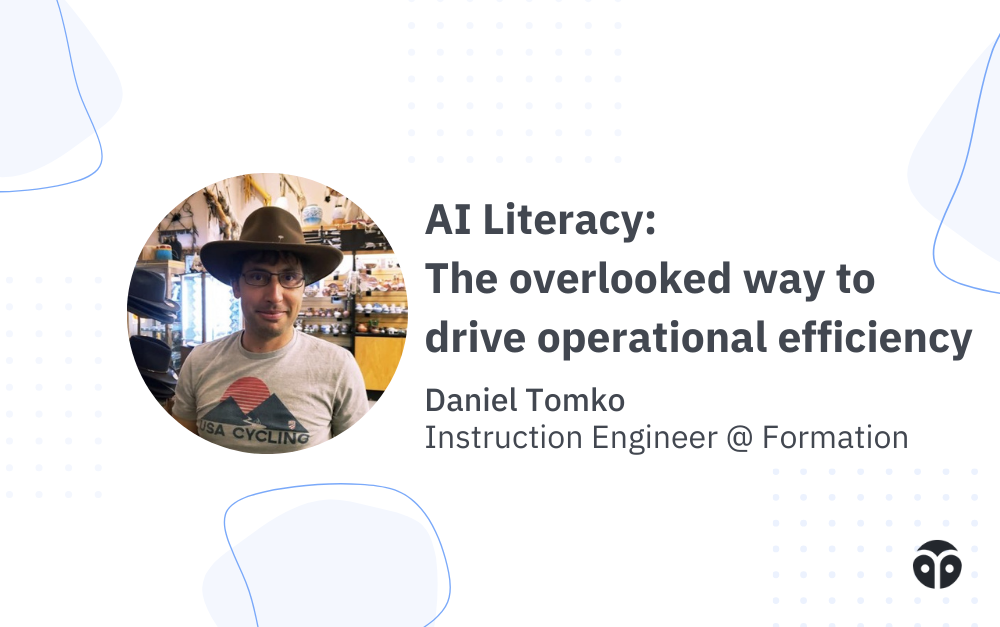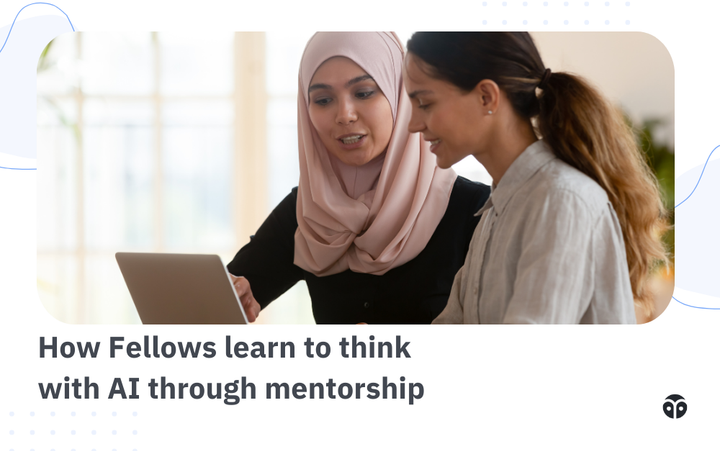AI Literacy: The overlooked way to drive operational efficiency
AI is reshaping how engineering work, but most orgs still struggle to see impact. Learn why AI literacy is the missing link to real productivity gains.

By Daniel Tomko
AI is no longer a toy. In 2025, artificial intelligence is reshaping how engineering teams write code, communicate, and make decisions. Meta predicts that AI will soon write most of its code. Microsoft says AI already generates 30%. And across the industry, companies are shifting from asking if they should use AI to asking how deeply they should integrate it.
Four out of five organizations say AI is a top priority. So why do so many still struggle to see results?
A recent BCG study found that 74% of organizations haven’t turned AI investments into real business value. The tools are powerful, but the outcomes often underwhelm. The reason isn’t usually model performance or infrastructure. It’s something more basic: the people using the tools haven’t had enough hands-on time to build judgment and skill.
That’s what AI literacy is. And that’s what’s missing.
What AI literacy really means
AI literacy doesn’t mean having experts on staff. It means creating a team culture where people are curious, willing to experiment, and iterating toward the desired results.
It’s the difference between dabbling and building instinct. Not every team needs to master prompting strategies or understand model architecture. But every team needs regular, low-stakes contact with AI to develop fluency.
That fluency shows up in small ways:
- Reaching for AI tools the same way you might reach for a search bar, a calculator, or a teammate
- Being willing to experiment and assess outputs critically
- Developing prompt patterns for common types of tasks and knowing how to tweak requests when things go sideways
- Seeing value in iteration — even if the first or second result isn’t great
Teams with high AI literacy are constantly trying things: a refactor here, an outline there, a review suggestion, a cleaner version of something already written.
Over time, that muscle memory builds. People start to notice patterns — when a prompt falls flat, when a model nails something out of the box, or when a few tweaks get you closer. They become better at judging what’s possible, what’s risky, and what’s just not worth the trouble yet.
What matters isn’t the outcome of any one experiment. It’s the fact that the experiments are happening consistently.
Why AI literacy leads to efficiency
That consistency leads somewhere powerful: speed.
McKinsey reports that AI tools can improve software engineering productivity by up to 45%. But that kind of gain doesn’t come from a single tool rollout or a training session. It comes from a progressive shift in how teams work.
When AI is second nature, teams iterate faster. They spend less time staring at blank pages. They reduce context-switching and create lighter-weight workflows, without needing a top-down push to transform.
And because AI can help people get unstuck, it shortens the time between “idea” and “output.” That’s when momentum compounds. Small cycles of trying, adjusting, and shipping start to define the rhythm of the team.
AI is a moving target, which is why you have to keep using it
One of the most important (and most frustrating) truths about AI is that what doesn’t work today might work perfectly tomorrow. The models improve fast. Release by release, capabilities shift and new patterns emerge.
That volatility isn’t a reason to hang back — it’s the reason to lean in.
Staying close to the tools is the only way to stay current. Regular contact is what lets teams spot breakthroughs early and avoid being surprised when yesterday’s limitation suddenly vanishes.
That’s the real value of AI literacy. It’s not just knowing how to use the tool. It’s knowing when to use it — and when not to. And that kind of judgment only comes from regular, low-stakes exposure.
You don’t have to read every changelog or perfect every prompt. You just have to keep moving. Try, adjust, revisit. The teams that build that reflex are the ones that spot breakthroughs early.
Encouraging AI literacy on your team: starting points that don’t feel high-stakes
You can’t mandate AI literacy, but you can build a culture that encourages it.
If you're trying to encourage AI literacy on an engineering team, start with something familiar and low-stakes: refactoring.
Have engineers use AI tools on code they’ve already written, not to generate new logic, but to improve clarity, simplify structure, or offer cleaner alternatives. Think of it like editing: the function stays the same, but the design improves.
This works because the engineer knows what the code is supposed to do. They can judge whether the AI’s suggestions help or hurt. It keeps them in the driver’s seat—but builds the habit of prompting, reviewing, and refining.
That habit is the foundation. Once it’s there, higher-impact use cases feel less risky.
If you’re a leader, model the behavior yourself. Use AI tools in your work. Share what you learn. That kind of example gives everyone else permission to try.
You can also:
- Keep a running list of useful prompts or workflows
- Share quick demos in team meetings
- Talk openly about failures, not just wins
- Make clear there’s no expectation to get it right on the first try
Review is how you get better
Remember: These models are improving rapidly, but they still make mistakes. Sometimes subtle ones.
That’s why every use of AI needs a human in the review seat. If it’s code, test it. If it’s text, read it. If it’s analysis, check the logic. This step isn’t optional, and it’s not a slowdown. It’s how people learn what to trust, and how to prompt better next time.
That review step is also part of the learning loop. It’s where trust gets built, and where fluency starts to stick.
The real shift AI demands isn’t technical — it’s cultural
The teams that benefit most from AI aren’t the ones with the flashiest tooling or biggest budgets. They’re the ones that treat AI as something to build with, not just build on top of. That requires a mindset shift from trying to nail the perfect use case to embracing a culture of small, continuous experiments.
Create a space where curiosity builds — where people feel safe to try, learn, and adjust in real time. That’s what unlocks speed, creativity, and real operational leverage.
If you want AI to change how your team works, you have to first change how your team learns. And that starts by making room to explore.
Invest in your engineering team’s growth with Formation
Formation helps companies invest in their engineers through personalized, expert-led training that actually sticks. If you’re looking to boost internal mobility, support career growth, or build a technical bench that’s ready for what’s next, partner with us to provide hands-on learning that complements your stack and priorities.



